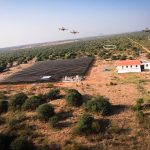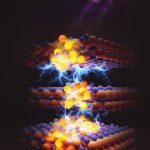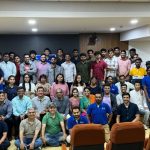Swetha Veeraraghavan’s lab studies how to make large structures, like dams and tunnels, withstand earthquakes
In 2004, a devastating tsunami, triggered by an undersea earthquake, struck the Tamil Nadu coast. The disaster wreaked havoc in the city of Chennai, Swetha Veeraraghavan’s hometown, sparking a curiosity in her. A year later, while doing her BTech in naval architecture and ocean engineering at IIT Madras, she attended a course on tsunamis, which only fueled her curiosity about their origins further. How are underwater earthquakes different from those on land? What factors can worsen the effects of earthquakes? How can we build structures that can withstand them? To dive deeper into such questions, she applied for an MTech and later PhD in civil engineering at the California Institute of Technology (Caltech), known for its extensive research on earthquakes.
Located in close proximity to rocky mountains, the Caltech campus provided ample opportunities for hikes and explorations. It was during her time here that she encountered the strange and exciting phenomenon of Precariously Balanced Rocks (PBRs) – naturally occurring geological features in which a boulder is balanced precariously on another, often larger, boulder. “The Echo Cliff PBR in the Santa Monica mountains looks like it will overturn if we simply push it. But it has actually withstood so many different earthquakes – these rocks have been around for more than 10,000 years! I was so surprised. How is that even possible?” she remarks.
Swetha set out to find out exactly that. What she learnt was that during an earthquake, the rock’s movement depends on its aspect ratio (height-to-width) and the frequency of the earthquake wave – how many times the ground moves from left to right and left again in one second. “Even in extreme earthquakes, if the frequency of the wave doesn’t match the characteristics of the rock, the latter will be stable. Whereas, if you go and actually push the rock, it will fall,” she says, laughing.
Following her PhD, she joined as a postdoctoral researcher at the Idaho National Laboratory in 2015, which was studying how earthquake fault lines can affect nuclear power plants located near them. “After the huge nuclear disaster following the 2011 Tōhoku earthquake in Japan, there was a lot of push to look at how huge structures respond to earthquakes,” she says. But Swetha was more interested in what happens below ground. “Soil is a huge mess. You don’t have a lot of control over what kind of soil is present in the region,” she shares. She was intrigued by how, depending on the soil’s grain size and moisture content, its response to earthquakes changes completely. “Either the soils tend to weaken the structure or they help to make the structure safer,” Swetha explains.
She got involved in developing a software tool to analyse the effect of ground motion on rocks. “They already had an open-source finite element software on top of which I was developing this [new] software, called MASTODON. I was adding the capability specific to analyse a big [earthquake] fault rupture, the wave propagation through the soil, and then the dynamic response of the structure,” she says.
After four years at Idaho, Swetha moved back to India, eager to continue her research. She joined IISc as an Assistant Professor in 2020. Around the same time, the Central Water Commission, which is part of the Ministry of Jal Shakti, approached IISc and IIT Roorkee, requesting that they offer courses for people working on dam sites. “They wanted us to find ways to make sure that dams across India are safe. Most of these dams are 300 years old,” she says. “During the 2001 Bhuj earthquake, several earthen dams failed. So, we started looking at those types of dams first.”
Her lab set out to identify key features of the dam site that affect its response to earthquakes, such as the soil water content and porosity as well as the geometry of the dam. “This helps us come up with the criteria for the type of material and geometry we need to design this dam, given we know the frequency of the earthquake that can occur and the basic soil properties in this region,” she explains.
So far, they have identified three key parameters that can determine whether the dam will stay steady or fall during an earthquake – the wavelength of the seismic wave, the crest width and height of the dam, and soil permeability (how fast water will drain out of it). “Now we are adding more complexities to see if these parameters hold out under more specific contexts,” explains Swetha. In collaboration with P Anbazhagan from the Department of Civil Engineering, her lab is also planning to do a case study of a dam in northern Karnataka, the Hidkal Dam, which has a small earthquake fault close to it.

These studies are essential, she explains, to ensure safety of life. “Once you know how these structures act under extreme events, you can strengthen the dam, or any structure, to make sure it stands. Or at least, even if that extreme event happens, there should be mechanisms to shut down the dam. There should also be some early trigger warnings, to safely evacuate the people in that region.”
Besides dams, her lab is also looking at the design of tunnels used for rail and road transport in hilly regions, and large water tunnels carrying water from dams, especially those that lie near earthquake fault lines. “We found that the radius of the tunnel, how deep it is embedded within the ground surface, and the tunnel liner material are the parameters that affect its response to earthquake waves. If you can tune the radius and the depth, you can make sure the tunnel is somewhat safe,” she explains.
Swetha’s lab is also investigating ways to protect existing structures from seismic waves by adding external structures in the soil around the perimeter to absorb and dampen the waves. This includes piles (vertical cylinders embedded in the ground), empty holes, or even geofoams (lightweight materials made of expanded polystyrene). “We are looking at how to efficiently design materials to work with earthquakes. That would be useful for protecting existing buildings and for new buildings as well, without changing the structure’s design,” she says.
At IISc, Swetha also teaches two courses – basic geo-mechanics, a compulsory course for all MTech civil engineering students, and an elective course on computational geo-techniques. Teaching, she says, was initially very challenging. “I was reluctant to come to academia as I was not sure if I would actually like teaching. But once I started interacting with students, that changed. It’s very interesting, the types of questions students ask,” she remarks, smiling. “I think teaching is definitely very helpful if you’re doing research. It helps you understand things better, and communicate the important aspects of your research to students.”
Swetha also credits her PhD mentors and teachers for shaping her career. She points out how, in their time, they had much fewer computational tools to work with, but were able to solve problems using “simple and elegant” approaches. “You need to understand the problem at a more basic level first … start simple, and then see how the problem progresses,” she explains. “That’s the way I am doing research right now.”






